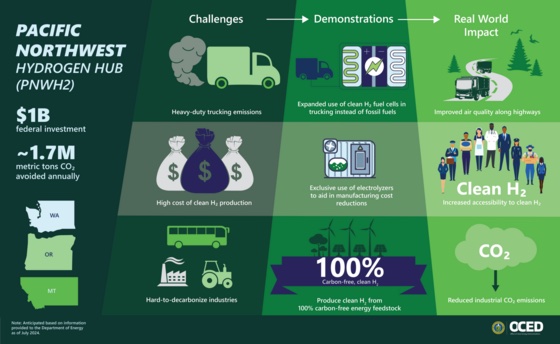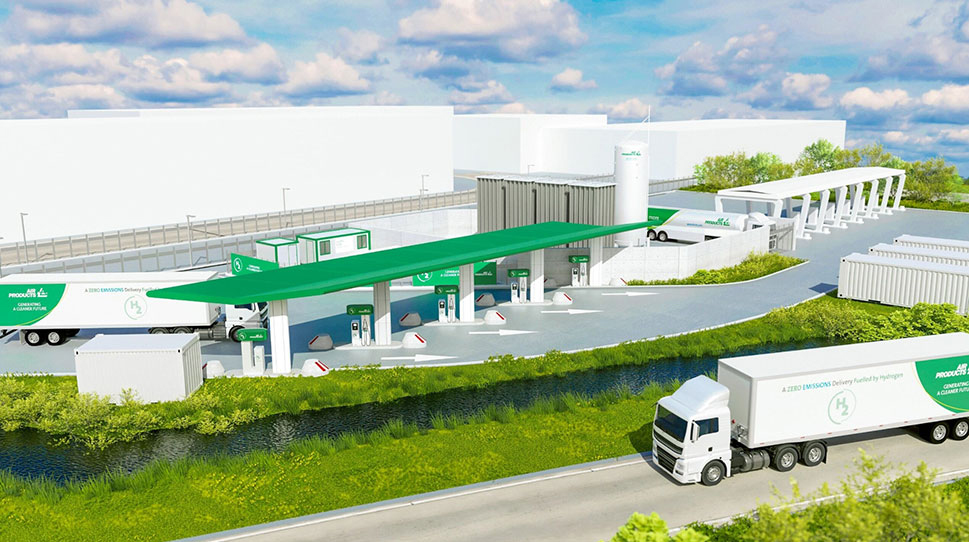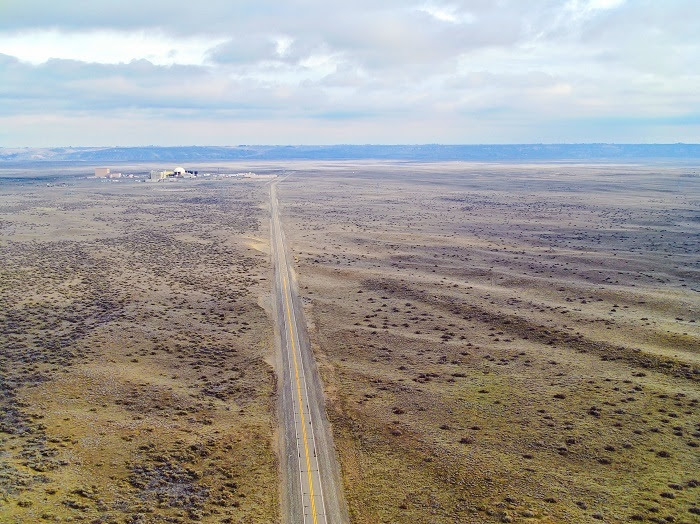The Pacific Northwest Hydrogen Hub (PNWH2) has entered phase one after being awarded $27.5 million by the U.S. Department of Energy (DOE) to become the second hydrogen hub to successfully exit the award negotiations phase.
The funding is the first tranche of the federal government’s up to $1 billion cost share, the DOE’s Office of Clean Energy Demonstrations (OECD) said July 24.
“Today marks an important step for the Pacific Northwest Hydrogen Association and is the culmination of many months of discussions, planning and negotiations across our partners, stakeholders and community members,” Chris Green, president of the Pacific Northwest Hydrogen Association, said in a statement July 24. “We are excited to embark on Phase 1 and lead the way in building a new clean energy commodity in the U.S. that will benefit generations of families throughout the region.”
PNWH2 was one of seven projects selected for negotiations last year to receive part of up to $7 billion to create hydrogen hubs across the U.S. The hubs are part of an effort to boost a sector that could have a big role in lowering greenhouse-gas emissions.

Located in Washington, Oregon and Montana, the PNWH2 hub aims to put to use the region’s abundant renewable resources to produce clean hydrogen via electrolysis using carbon-free energy. Plans are to link to the California Hydrogen Hub. Developers aim to reduce carbon emissions by 1.7 MMmt/year, which is roughly the equivalent to annual emissions of 400,000 gasoline-powered cars, according to the DOE.
The hub consists of eight project groups, called nodes, that include five sites in Washington, two sites in Oregon and one site in Montana. Hydrogen produced will be used for agriculture, heavy-duty transportation, power generation, public transportation and refining.
Partners include Air Liquide, Amazon, MHI Hydrogen Infrastructure and others.
The project now moves into Phase 1 to carry out planning, analysis, design activities and more stakeholder and community engagement. The phase is expected to last up to 18 months, according to the DOE.
During this time, PNWH2 will carry out activities that include planning, analysis, design, and community and labor engagement. The Pacific Northwest Hydrogen Association and partners will host a webinar on Aug. 21 to share additional information and answer questions about the hub.
Here’s a look at other renewable energy news this week.
Bioenergy
Clean Energy Begins RNG Project at Texas Dairy Farm
Clean Energy Fuels Corp. has broken ground on a renewable natural gas (RNG) production facility at South Fork Dairy in Dimmitt, Texas. Construction of anaerobic digesters and the processing plant is forecast to cost approximately $85 million with expected completion in 2025, the company said in a July 24 press release.
The dairy farm, home to a 16,000-cow herd, will produce RNG made from organic waste that Clean Energy said receives a negative carbon-intensity score.
Clean Energy said the South Fork Dairy facility is set to be one of the biggest RNG production developments in the country with an anticipated annual production 2.6 MMgal. RNG fuel produced at the site will make its way into Clean Energy's nationwide network of stations.
The South Fork project will help the farm monetize sizeable amounts of manure waste while also benefiting from the environmental credits an RNG facility brings, Clay Corbus, senior vice president of renewables at Clean Energy, said in a press release.
"The project not only helps us convert our waste into a clean, useable sustainable fuel, but it also helps us with managing manure which for a dairy of our size is quite a feat,” said Frand Brand, owner of South Fork Dairy. “We do this while simultaneously reducing our environmental footprint – it’s a direction I hope many other dairies will look to pursuing."
Agriculture accounts for nearly 10% of U.S. greenhouse-gas (GHG) emissions, according to the U.S. Environmental Protection Agency.
Capturing methane from farm waste can lower these emissions. RNG is a transportation fuel made entirely from organic waste and reduces GHG emissions by an average of 300% compared to diesel, according to Clean Energy.
RELATED
Cemvita Rolls Out Biotech to Boost Sustainable Oil Production
Energy storage
GM Ventures Co-leads $39MM Funding Round for Battery Tech Co
Battery tech company Addionics raised $39 million in a Series B funding round co-led by GM Ventures and Deep Insight.
Addionics said it will use the funds to strengthen its manufacturing capabilities and advance business engagements, according to a July 25 news release.
The investment allows the company to “build up teams across the globe, and expand its manufacturing and commercialization efforts, including advancing the construction of its planned U.S.-based giga-factory for the production of Addionics 3D Current Collectors,” the release said.
The company plans to start commercial production of its technology by year-end 2024.
Hydrogen
Air Products Plans to Build Hydrogen Refueling Station Network

Pennsylvania-headquartered Air Products said on July 25 it plans to build a network of permanent, commercial-scale hydrogen refueling stations in Europe.
Located along major transportation corridors near the Trans-European Transport Network, “this infrastructure will help connect key locations across Europe and support the advancement of a safe and resilient hydrogen ecosystem,” Air Products said.
The company said it will supply the hydrogen from its global hydrogen supply chain network, including the hydrogen liquefaction plant the company is building in Rotterdam.
Air Products also has partnered with Daimler Truck on a hydrogen truck pilot project at Air Products’ fueling station in Duisburg, Germany. Five Mercedes-Benz GenH2 trucks will be allowed to refuel with liquid hydrogen at the station as part of customer trials.
“With thousands of trucks delivering industrial gases to our customers every day, logistics is an integral part of our business,” said Air Products CEO Seifi Ghasemi. “Trialing a Mercedes-Benz GenH2 Truck under real conditions is a critical step in our work to convert our distribution fleet to hydrogen-powered vehicles.”
Air Products said liquid hydrogen enables a range of more than 1,000 km for the trucks.
Pajarito Powder Lands Investment from Ecovyst
Chemicals company Ecovyst has made a $4.5 million equity investment in Pajarito Powder, which makes catalysts for electrolyzers and fuel cells, according to a July 25 news release.
Pajarito, which plans to use the investment to advance its technology and build its business, is also expected to work with Ecovyst on joint development efforts, Ecovyst said. Projects could include use of mesoporous carbon for new applications.
“Ecovyst has already developed deep internal capabilities to serve renewable and sustainable fuels, bio-catalysis and carbon capture and sequestration. Investing in emerging catalyst technologies focused on the hydrogen economy is a logical next step for us,” said Ecovyst CEO Kurt Bitting.
Ecovyst also said it will appoint a representative to Pajarito’s board of directors.
Solar
Hecate, DOE to Enter Land Deal for Solar Project

Chicago-based Hecate Energy, a renewable energy developer, will enter realty negotiations with the DOE for a solar project that could deliver up to 1 gigawatts (GW) of energy at a former plutonium production site, the federal government said July 25.
The negotiations are part of an initiative, called the Cleanup to Clean Energy, that aims to repurpose parts of DOE-owned land. The negotiations between Hectate and DOE involve land within 8,000-acre area of DOE-owned Hanford Site, where plutonium was produced for U.S. nuclear weapons.
“Since the beginning of the Biden-Harris Administration, we’ve added nearly 90 gigawatts of solar capacity to the grid—enough to power roughly 13 million homes—and we’re building on this historic progress with another massive solar project,” said U.S. Secretary of Energy Jennifer M. Granholm. “With today’s announcement, DOE is transforming thousands of acres of land at our Hanford Site into a thriving center of carbon-free solar power generation, leading by example in cleaning up our environment and delivering new economic opportunities to local communities.”
Hecate Energy, which the DOE said was selected by a competitive qualifications-based process, will have a chance to negotiate a realty agreement for up to 8,000 acres at Hanford. The DOE may cancel negotiations and rescind the selection for any reason during the negotiations process.
Canadian, Indian Solar Firms Join Forces on US Cell Factory
Canada’s Heliene and India’s Premier Energies are planning a 1-GW solar cell factory in the U.S. to satisfy demand for domestically made solar energy equipment.
The U.S. solar manufacturing industry needs a domestic supply of cells, the building blocks of solar panels, in order to make products that can qualify for a generous new subsidy for American-made clean energy equipment.
Currently, the U.S. has no suppliers of silicon solar cells, and President Joe Biden’s administration has been seeking to build up the domestic industry to compete with China.
Heliene and Premier Energies expect to begin production at their facility in the second quarter of 2026. The factory will be located in the Minneapolis, Minnesota, area.
The facility will supply Heliene’s existing U.S. module factories, which are located in Minnesota.
Wind
US Seeks Bids for Wind Acreage Off Texas after Hecate Expresses Interest
The U.S. Bureau of Ocean Energy Management (BOEM) said on July 26 it is seeking competitive bids for offshore wind leases off the coast of Texas after renewable energy developer Hecate Energy Gulf Wind LLC made an unsolicited bid.
The Biden administration sees offshore wind power as a vital part of a broader strategy to decarbonize the U.S. power sector to fight climate change, but the nascent industry faces strong local opposition in some areas over concerns about ocean views and damage to sea life.
Leases are typically sold at scheduled auctions and BOEM billed the unsolicited bid from Hecate as evidence of the commercial potential of wind power in the Gulf of Mexico.
“The Gulf region benefits from great offshore wind resources and existing energy infrastructure,” said BOEM’s Gulf of Mexico regional director James Kendall in a press release.
A lease auction in the region last year drew paltry interest.
BOEM said Hecate was seeking acreage off the coast of southeast Texas within a roughly 142,000-acre region that had been set aside for offshore wind leasing in 2021. It did not provide details of Hecate’s bid.
A Hecate representative was not immediately available to comment.
BOEM said if it receives at least one additional bid on the area, it will consider scheduling a lease sale. Otherwise it may issue the noncompetitive lease to Hecate.
Reuters and Hart Energy contributed to this report.
Recommended Reading
On The Market This Week (Jan. 20, 2025)
2025-01-24 - Here is a roundup of marketed oil and gas interests in the Delaware Basin, Midcontinent and Bakken from select sellers.
VAALCO Acquires 70% Interest in Offshore Côte D’Ivoire Block
2025-03-03 - Vaalco Energy announced a farm-in of CI-705 Block offshore West Africa, which it will operate under the terms of an acquisition agreement.
Continental Resources Signs JV to Explore Shale Oil, Gas in Turkey
2025-03-12 - Early evaluations from the joint venture between Continental Resources, Türkiye Petroleum and TransAtlantic Petroleum suggest ultimate recoverable reserves could reach 6 Bbbl of oil and 32 Tcf to 65 Tcf of gas.
Helmerich & Payne Seals $1.97B Deal for KCA Deutag
2025-01-16 - Helmerich & Payne has completed its acquisition of KCA Deutag International Ltd. as it positions itself as a global onshore drilling powerhouse.
TotalEnergies Enters 10-Year LNG Supply Deal with Indian E&P
2025-02-12 - Commencing in 2026, TotalEnergies will supply Gujarat State Petroleum Corp. with 400,000 tons of LNG, amounting to six cargoes per year, to terminals on India's west coast.
Comments
Add new comment
This conversation is moderated according to Hart Energy community rules. Please read the rules before joining the discussion. If you’re experiencing any technical problems, please contact our customer care team.






